Musicarta Twelve-bar Piano Styles
Moving Pair - Module Five
The Moving Pair riff – Two-plus-two format
It’s very easy to get stuck with just one version of a particular ‘trick’ and miss out on all the other variations you have practically already learnt.
This Moving Pair module adds another root note above the moving pair and divides the notes two to each hand – giving you a new slant on ‘seeing the music in the keyboard’.
Here’s the main module riff.
As you can hear, it sounds ‘fatter’ and has more impact. More importantly, it splits the notes between the hands differently, opening the way to yet more combinations.
Finding the notes
Find the following four-note chords. (These are the starting positions only – this is not the riff, yet.)
- The root (name-note of the chord) has been ‘doubled’ – there are now two of them, top and bottom, with the moving pair in between them.
- There are two notes in the left and two in the right. The notes are colour-coded green for left and red for right. These are the same colours that show when you play the series MIDI files on MidiPiano
Use any fingers for now.
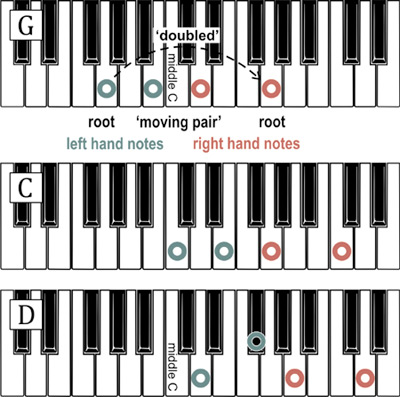
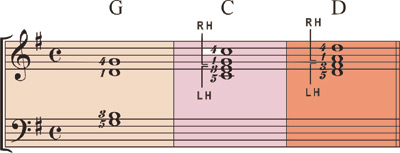
Finger the chords
In order to move forward, you have use fingering that’s going to allow you to play what’s coming up next. The ‘right fingering’ is shown on the keyboards below.
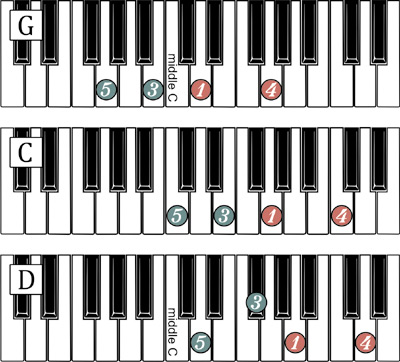
This is the fingering given in the written-out music example above. Fingering in written-out music is always tiny and very easy to overlook, but make an effort to pay attention – bad fingering will trip you up every time until you fix it, and it’s easier to get into good habits early on than fix bad habits later.
|
As you can see in this sample G position photo, the hands are right up against each other – perhaps an unusual feeling. The left hand thumb is over the right hand thumb, ready to play the note D in its turn. Find the three starting chords again, using the proper fingering.
|
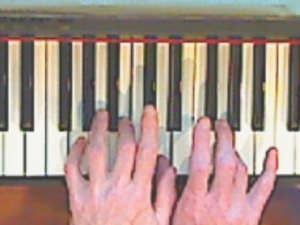 |
Move the pair
The next task is to move the ‘moving pair’ up and down as before – but now the moving pair is one left hand and one right hand note, inside the two stay-the-same top and bottom notes:
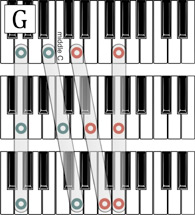 |
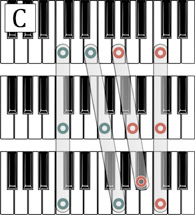 |
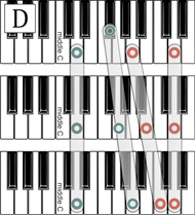 |

This fingering diagram applies to all three chords:
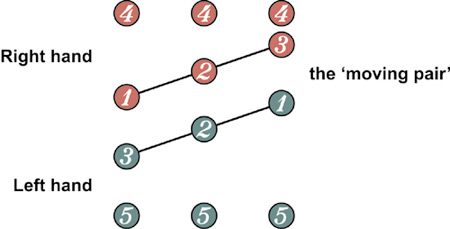
This is the fingering indicated in the written-out music, as well.
Making your own practice drills
Whenever you get a new thing like this to learn, break it down and practice it methodically. This will speed your progress and save frustration.
Always ask yourself:
- What does just the right hand do? (… and practice just that…)
- What does just the left hand do? (.. and practice just that …)
- What fingering is going to be effective?
- What things happen at the same time? What ‘goes with’ what?
Here’s a model practice drill. The player is ‘looking at the material from all angles’ and working every aspect of it thoroughly. (You can almost hear possible new riffs emerging from just the practicing!)
Watching the drill on MidiPiano is particularly helpful here.
Building the riff
Now, without the kick note, apply the
rhythm and movement of the original Moving Pair riff to this new four-note arrangement.
Do this in the G, C and D positions.
Next, add the right hand ‘kick’ note.
The RH kick note fingering is this:
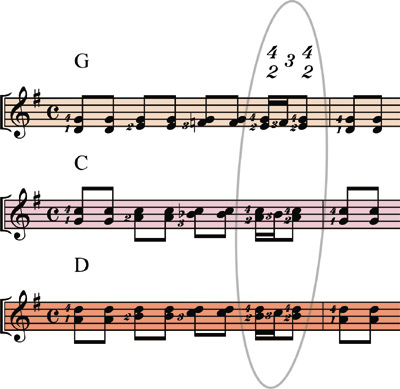 |
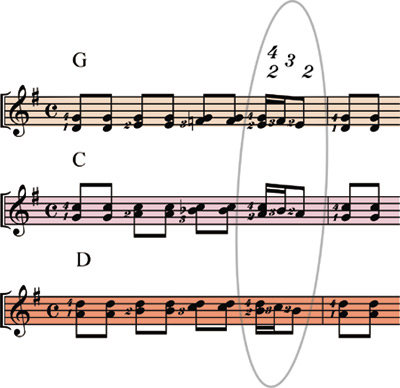 |
The version on the right is slightly easier – you miss out the second right hand finger four of the ‘kick’.
Next, try some left hand little finger (LH5) anticipation. As before, you can drop the right hand kick note until you’ve had a bit of practice.
Practice the movement in the three positions, G, C, and D, as in the performance clips. In the audio and MIDI performance clips, the left hand actually plays this:
Your version doesn’t have to be exactly the same as the audio clip - you could have more, or less, syncopation. The best way forward is just to copy, see what you can keep playing, and build on that.
That goes generally, too. Don’t wait for perfection before going on to the next thing. Get a decent “for now” version going, and bookmark for further practice. It’s more important at this point that you get an idea of the many different ways the ‘moving pair’ can be made into good keyboard grooves.
Fingering popular music
Popular music isn’t easy to play, just because it’s popular – and finger exercises aren’t just for classical musicians!
You should have a book of finger exercises, like the Preparatory Exercises by Aloys Schmitt or The Virtuoso Pianist by Charles-Louis Hanon – and a regular practice schedule for getting through them. Quite simply, finger exercises improve your ability to play the music you want.
Both sets of exercises are out of copyright. You can download them using these Hanon and Schmitt links. (Links open a browser window - download from there.) Once you understand the Hanon patterns, you can use this shorthand version.
Try adding the right hand kick back in. The kick note will come with the before-the-beat left hand little finger. The MidiPiano “Piano Roll” view shows this clearly.
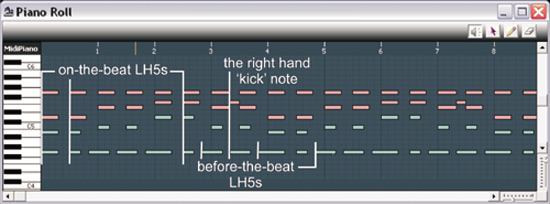
The Performance Troubleshooting module suggested you ask the question:
- What things happen at the same time? What ‘goes with’ what?
MidiPiano is perfect for dispelling confusion over things like this – and generally tightening up ‘what comes with what’. In addition, this kind of ‘aerial view’ puts you much more in charge of the music-making than only seeing as far as the next note!
The whole riff in two-plus-two format
It’s more efficient to practice sections before putting it all together, but once you have some proficiency, go on to fill up the chord sequence with your performance of the two-plus-two Moving Pair riff.

Here’s the Module riff again, for reference.
Practice methodically! Go through, at practice speed:
- With just the basic riff (two-plus-two format);
- With the right hand kick note;
- With left hand anticipation (only); and
- With both.
Take that ‘at practice speed’ seriously! It’s much better to practice slowly but in time than to practice up to speed and have delays in the music. It’s difficult to break the habit of giving yourself that extra bit of time to get there, especially if you play alone a lot.
You will probably need to work on the jumps between positions.
This mini chord sequence from Module Three is an efficient way of practising just the jumps.
Play that same practice sequence in the two-plus-two format.
Module summary
This module has presented a lot of difficult keyboard styling which could well beyond your abilities, initially. The good news is that practice works, and, like the tortoise in the fable, the mental stamina to keep coming back to it always wins the day.
Here's the module tutorial video.
Also, you might never need a stage-perfect, hard-driving keyboard riff like this – the riffs you end up using might well be slower. But you still need to be accurate, especially for recording, so listen carefully to your playing and ‘clean up’ relentlessly.
Lastly, dissecting and recombining the elements of this riff isn’t just an exercise for the sake of it. It’s your key to keyboard creativity, as you’ll see from the bluesy Moving Pair version in the next module.
|
OUT NOW! |
THE MUSICARTA BEAT & RHYTHM WORKBOOK At last! An effective approach to keyboard rhythm & syncopation skills. Learn more! |
ONLY $24.95! |
TWELVE-BAR |
The MusicartaA methodical approach to keyboard syncopation for
|
PUBLICATIONS
exciting keyboard
creativity courses
CHORDS 101
WORKBOOK

~HANON~
video course

Musicarta
Patreon
PENTATONICS
WORKBOOK
video course

Creative Keyboard
video course

BEAT AND RHYTHM
WORKBOOK

- Volume 1 -

12-BAR PIANO
STYLES WORKBOOK

MUSICARTA MODES
WORKBOOK

PIANO STYLE

CANON PROJECT
video course

VARIATIONS
video course


- Piano Solo -
video course

- Piano Solo -


YouTube playlists





 THE LOGO
THE LOGO
